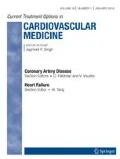Opinion statement
Vertebrobasilar insufficiency presents with characteristic symptoms and signs due to impaired perfusion of the cerebellum, the brain stem, and the occipital cortex. This may be due to reduced perfusion usually due to atherosclerosis or thromboembolism. Choice of treatment depends on understanding the different underlying pathophysiologic mechanisms. Antiplatelet therapy; reduction of risk factors such as diabetes, hypertension, hypercholesterolemia, and cigarette smoking; and a healthy lifestyle form the first line of management. Systemic anticoagulation in the short term also has a key role in selected cases. In patients with refractory symptoms on maximal medical therapy and underlying focal stenotic lesions, endovascular revascularization using stents and balloon angioplasty may be indicated. Bypass surgery is another option if there are factors that render endovascular therapy unsuitable.
Similar content being viewed by others
References and Recommended Reading
Bamford J, Sandercock P, Dennis M, et al.: Classification and natural history of clinically identifiable subtypes of cerebral infarction. Lancet 1991, 337:1521–1526.
Bogousslavsky J, van Melle G, Regli F: The Lausanne Stroke Registry: analysis of 1000 consecutive patients with first stroke. Stroke 1988, 19:1083–1092.
Lang E, Afilalo M: Vertebrobasilar atherothrombotic disease. eMedicine [serial online]. http://www.emedicine. com/emerg/topic834.htm.July 2, 2004.
British National Formulary: rtPA, Heparin, Clopidogrel, Ticlopidine, Dipyridamole, Atorvastatin, ACE inhibitors and Abciximab. http://www.bnf.org/ bnf/bnf/current/openat/index.htm.
Wardlaw JM, del Zoppo G, Yamaguchi T: Thrombolysis for acute ischaemic stroke (Cochrane Review). In The Cochrane Library, Issue 3 (update software). Oxford: 2001.
Chimowitz MI, Lynn MJ, Howlett-Smith H, et al.: Comparison of warfarin and aspirin symptomatic intracranial arterial stenosis. N Engl J Med 2005, 352:1305–1316. Randomized comparison of high-dose aspirin with warfarin (INR 2–3) in patients with intracranial major arterial stenosis showed that warfarin was associated with significantly higher rates of adverse events and provided no benefit over aspirin in the long term. However, this does not preclude short-term use of anticoagulants in the acute phase.
Koroshetz WJ: Warfarin, aspirin and intracranial vascular disease. N Engl J Med 352:1368-1370.
Chen ZM, Sandercock P, Pan HC, et al.: Indications for early aspirin use in acute ischemic stroke: a combined analysis of 40,000 randomized patients from the Chinese acute stroke trial and the international stroke trial. On behalf of the CAST and IST collaborative groups. Stroke 2000, 31:1240–1249.
Jones L, Griffin S, Palmer S, et al.: Clinical effectiveness and cost-effectiveness of clopidogrel and modifiedrelease dipyridamole in the secondary prevention of occlusive vascular events: a systematic review and economic evaluation. Health Technol Assess 2004, 8(38). http://www.ncchta.org/execsumm/summ838.htm.
Diener HC, Bougousslavsky J, Brass LM, et al.: Aspirin and clopidogrel compared with clopidogrel alone after recent ischaemic stroke or transient ischaemic attack in high-risk patients (MATCH): randomized, double-blind, placebo-controlled trail. Lancet 2004, 364:331–337. Randomized controlled trial comparing aspirin versus aspirin and clopidogrel in high-risk patients showed that combination antiplatelet therapy led to increased hemorrhagic complications long term. However, the data supports the use of combination antiplatelet therapy in the acute setting of TIA.
A randomised, blinded, trial of clopidogrel versus aspirin in patients at risk of ischaemic events (CAPRIE). CAPRIE steering committee [no authors listed]. Lancet 1996, 348:1329-1339.
Diener HC: Secondary prevention of stroke with antiplatelet drugs. Med Klin (Munich) 2004, 99(suppl 1):21–25.
Colhoun HM, Betteridge DJ, Durrington PN: Primary prevention of cardiovascular disease with atorvastatin in type 2 diabetes in the Collaborative Atorvastatin Diabetes Study (CARDS): multicentre randomised placebo-controlled trial. Lancet 2004, 364:685–696.
Chalmers J, MacMahon S: Perindopril Protection Against Recurrent Stroke Study (PROGRESS): interpretation and implementation. J Hypertens Suppl 2003, 21(suppl 5):S9-S14.
Hass WK, Fields WS, North RR, et al.: Joint study of extracranial arterial occlusion. II. Arteriography techniques, sites, and complications. JAMA 1968, 203:961–968.
Chastain HD, Campbell MS, Iyer S, et al.: Extracranial vertebral artery stent placement: in-hospital and follow-up results. J Neurosurg 1999, 91:547–552.
Jenkins JS, White CJ, Ramee SR, et al.: Vertebral artery stenting. Catheter Cardiovasc Interv 2001, 54:1–5.
Malek AM, Higashida RT, Phatouros CC, et al.: Treatment of posterior circulation ischaemia with extracranial percutaneous balloon angioplasty and stent placement. Stroke 1999, 30:2073–2085.
Thijs VN, Albers GW: Symptomatic intracranial atherosclerosis: outcome of patients who fail antithrombotic therapy. Neurology 2000, 55:490–497.
Stenting of Symptomatic Atherosclerotic Lesions in the Vertebral or Intracranial Arteries (SSYLVIA) Study results. The SSYLVIA Study Investigators [no authors listed]. Stroke 2004, 35:1388-1392. Feasibility study on the use of an intracranial stent for cerebral atherosclerotic and vertebral artery origin stenosis showed high rate of success in deployment. A third of all patients had recurrent stenosis. However, approximately 60% of these patients were asymptomatic and the majority was in the ostium of the vertebral artery. A small percentage of patients had short-term postprocedural stroke rate, particularly in the posterior circulation.
Qureshi AI: Endovascular treatment of cerebrovascular diseases and intracranial neoplasms. Lancet 2004, 363:804–813.
Cloud GC, Crawley F, Clifton A, et al.: Vertebral artery origin angioplasty and primary stenting: safety and restenosis rates in a prospective series. J Neurol Neurosurg Psychiatry 2003, 74:586–590.
Albuquerque FC, Fiorella D, Han P, et al.: A reappraisal of angioplasty and stenting for the treatment of vertebral origin stenosis. Neurosurgery 2003, 53:607–614.
Qureshi AI, Ringer AJ, Suri MF, et al.: Acute interventions for ischaemic stroke: present status and future directions. J Endovasc Ther 2000, 7:423–428.
Phatouros CC, Higashida RT, Malek AM, et al.: Endovascular treatment of noncarotid extracranial cerebrovascular disease. Neurosurg Clin N Am 2000, 11:331–350.
Mahon BR, Nesbit GM, Barnwell SL, et al.: North American Clinical Experience with the EKOS MicroLysUS infusion catheter for treatment of embolic stroke. Am J Neuroradiol 2003, 24:534–538.
Lutsep HL, Campbell M, Clark WM: EPAR therapy system for treatment of acute stroke: safety study results. Stroke 2001, 32:319b.
Levy EI, Hanel RA, Howington JU, et al.: Sirolimuseluting stents in the canine cerebral vasculature: a prospective, randomized, blinded assessment of safety and response. J Neurosurg 2004, 100:688–694.
Author information
Authors and Affiliations
Rights and permissions
About this article
Cite this article
Doss, A., Phatouros, C.C. Vertebrobasilar insufficiency. Curr Treat Options Cardio Med 8, 111–119 (2006). https://doi.org/10.1007/s11936-006-0003-0
Issue Date:
DOI: https://doi.org/10.1007/s11936-006-0003-0




